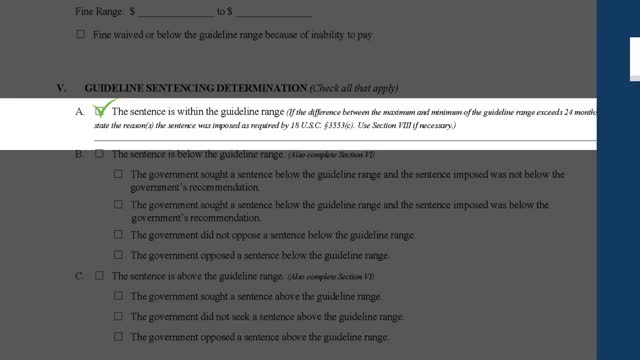Court Guidelines Require Detailed Justifications for Sentence Variations
October 02, 2025 | United States Sentencing Commission, United States Courts, Judiciary, Federal
This article was created by AI summarizing key points discussed. AI makes mistakes, so for full details and context, please refer to the video of the full meeting. Please report any errors so we can fix them. Report an error »

The recent government meeting on October 2, 2025, focused on the Statement of Reasons Instruction by United States Courts, outlining critical procedural guidelines for sentencing documentation. The meeting emphasized the importance of accurately recording the rationale behind sentencing decisions, particularly when they deviate from established guideline ranges.
Key discussions highlighted the necessity for judges to provide clear reasons when the difference between the maximum and minimum of a sentencing range exceeds 24 months. Participants were reminded that this documentation is mandated by statute, requiring concise statements that justify the chosen sentence. For instance, a judge might note that a lower sentence aligns with the requirements of 18 USC section 3553(a).
The meeting also addressed the process for indicating whether a sentence falls below or above the guideline range. Attendees were instructed to check specific boxes that reflect the government's position on the sentence, which could be articulated during the sentencing hearing or through prior filings. This ensures transparency and consistency in judicial decisions.
Further, the meeting detailed the importance of Section 6 of the form, which requires judges to outline reasons for imposing sentences outside the guideline range. Participants were encouraged to check all applicable boxes in this section, as it is crucial to capture the full context of the sentencing decision. This includes factors such as the nature of the offense and the defendant's history and characteristics.
Additionally, the meeting covered the documentation of restitution orders, with specific boxes designated for cases where restitution is applicable or not. The final section of the form allows for additional explanations, ensuring that judges have the opportunity to provide comprehensive reasoning for their decisions.
Overall, the meeting underscored the significance of thorough and precise documentation in the sentencing process, aiming to enhance the clarity and accountability of judicial decisions in the United States.
Key discussions highlighted the necessity for judges to provide clear reasons when the difference between the maximum and minimum of a sentencing range exceeds 24 months. Participants were reminded that this documentation is mandated by statute, requiring concise statements that justify the chosen sentence. For instance, a judge might note that a lower sentence aligns with the requirements of 18 USC section 3553(a).
The meeting also addressed the process for indicating whether a sentence falls below or above the guideline range. Attendees were instructed to check specific boxes that reflect the government's position on the sentence, which could be articulated during the sentencing hearing or through prior filings. This ensures transparency and consistency in judicial decisions.
Further, the meeting detailed the importance of Section 6 of the form, which requires judges to outline reasons for imposing sentences outside the guideline range. Participants were encouraged to check all applicable boxes in this section, as it is crucial to capture the full context of the sentencing decision. This includes factors such as the nature of the offense and the defendant's history and characteristics.
Additionally, the meeting covered the documentation of restitution orders, with specific boxes designated for cases where restitution is applicable or not. The final section of the form allows for additional explanations, ensuring that judges have the opportunity to provide comprehensive reasoning for their decisions.
Overall, the meeting underscored the significance of thorough and precise documentation in the sentencing process, aiming to enhance the clarity and accountability of judicial decisions in the United States.
View full meeting
This article is based on a recent meeting—watch the full video and explore the complete transcript for deeper insights into the discussion.
View full meeting